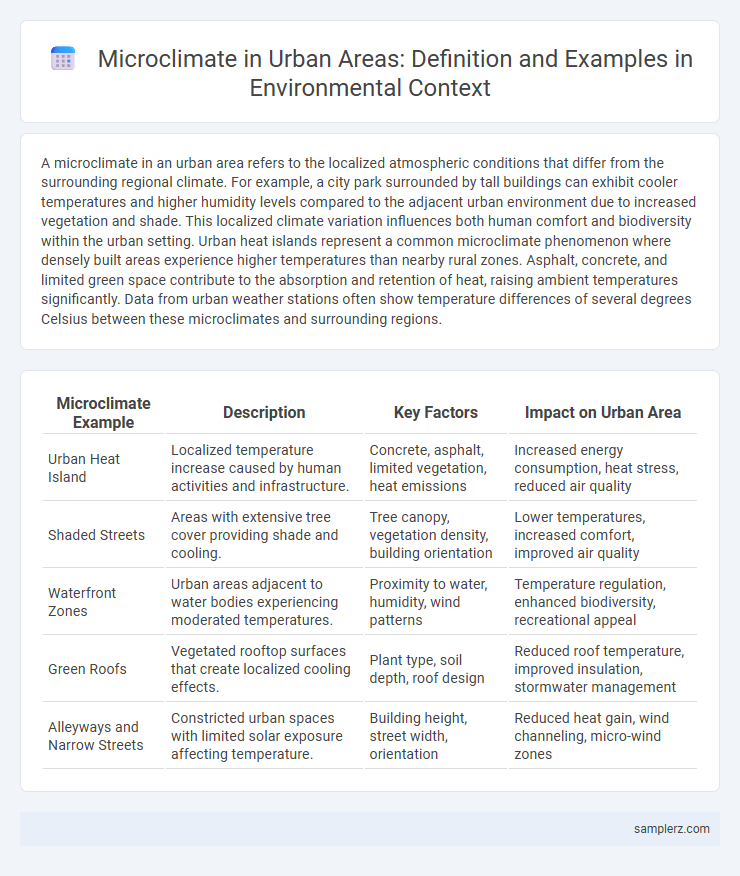A microclimate in an urban area refers to the localized atmospheric conditions that differ from the surrounding regional climate. For example, a city park surrounded by tall buildings can exhibit cooler temperatures and higher humidity levels compared to the adjacent urban environment due to increased vegetation and shade. This localized climate variation influences both human comfort and biodiversity within the urban setting. Urban heat islands represent a common microclimate phenomenon where densely built areas experience higher temperatures than nearby rural zones. Asphalt, concrete, and limited green space contribute to the absorption and retention of heat, raising ambient temperatures significantly. Data from urban weather stations often show temperature differences of several degrees Celsius between these microclimates and surrounding regions.
Table of Comparison
| Microclimate Example | Description | Key Factors | Impact on Urban Area |
|---|---|---|---|
| Urban Heat Island | Localized temperature increase caused by human activities and infrastructure. | Concrete, asphalt, limited vegetation, heat emissions | Increased energy consumption, heat stress, reduced air quality |
| Shaded Streets | Areas with extensive tree cover providing shade and cooling. | Tree canopy, vegetation density, building orientation | Lower temperatures, increased comfort, improved air quality |
| Waterfront Zones | Urban areas adjacent to water bodies experiencing moderated temperatures. | Proximity to water, humidity, wind patterns | Temperature regulation, enhanced biodiversity, recreational appeal |
| Green Roofs | Vegetated rooftop surfaces that create localized cooling effects. | Plant type, soil depth, roof design | Reduced roof temperature, improved insulation, stormwater management |
| Alleyways and Narrow Streets | Constricted urban spaces with limited solar exposure affecting temperature. | Building height, street width, orientation | Reduced heat gain, wind channeling, micro-wind zones |
Urban Courtyards: Microclimate Oases
Urban courtyards act as microclimate oases by reducing ambient temperatures and improving air quality within densely built environments. These small, enclosed green spaces moderate heat through increased shading and evapotranspiration from plants, creating cooler and more comfortable conditions compared to surrounding urban heat islands. Studies show courtyard designs with vegetation can lower temperatures by up to 5degC and enhance thermal comfort for residents.
The Impact of Green Roofs on City Temperature
Green roofs significantly reduce urban heat island effects by lowering rooftop temperatures by up to 40degF (22degC), creating cooler microclimates in densely built areas. Vegetative layers improve air quality and increase humidity through evapotranspiration, which mitigates extreme temperature fluctuations. Studies in cities like New York and Tokyo demonstrate that widespread adoption of green roofs can decrease city-wide temperatures by approximately 1-3degC, enhancing urban comfort and reducing energy consumption.
Alleyways: Unique Microclimates Between Buildings
Alleyways in urban areas create unique microclimates characterized by reduced sunlight exposure and limited airflow, leading to cooler temperatures and higher humidity compared to surrounding streets. These narrow passages often accumulate moisture and pollutants, influencing vegetation growth and localized air quality. Understanding the microclimate of alleyways aids in urban planning and environmental management to enhance comfort and ecological health.
Influence of Parking Lots on Local Heat Islands
Parking lots significantly contribute to urban heat islands by absorbing and retaining solar radiation due to their extensive asphalt surfaces, raising local temperatures by several degrees compared to surrounding vegetated areas. The lack of vegetation and high thermal mass of paved materials reduce natural cooling through evapotranspiration, intensifying heat stress in nearby neighborhoods. Studies show that heat emitted from parking lots can increase ambient temperatures by up to 5degC during peak summer hours, exacerbating energy consumption and health risks in dense urban zones.
Street Canyon Effect: Temperature Variations in Narrow Streets
The Street Canyon Effect in urban areas causes significant temperature variations due to the trapping of heat within narrow streets lined by tall buildings, creating localized microclimates. These confined spaces reduce air flow and increase solar radiation absorption, leading to elevated temperatures compared to surrounding open areas. This phenomenon contributes to urban heat islands and impacts energy consumption and human comfort in cities.
The Role of Urban Parks in Cooling Microclimates
Urban parks significantly contribute to cooling microclimates by providing shaded areas and increasing evapotranspiration, which reduces surrounding air temperatures. Tree canopies and water features within these parks enhance natural cooling effects, mitigating urban heat island impacts. Studies indicate that parks can lower local temperatures by up to 5degC compared to adjacent urban zones dominated by concrete and asphalt.
Shaded Bus Stops: Shelter and Microclimate Relief
Shaded bus stops create localized microclimates by reducing ambient temperatures and providing shelter from direct sunlight, significantly improving thermal comfort for urban commuters. The shade lowers surface temperatures by up to 10degC compared to unshaded areas, mitigating heat island effects in densely built environments. Incorporating vegetation and reflective materials in bus stop design enhances cooling effects and air quality, contributing to urban microclimate relief.
Roof Gardens: Enhancing Urban Microclimate Diversity
Roof gardens create localized cooling effects by reducing surface temperatures and mitigating the urban heat island phenomenon in cities. These vegetated spaces enhance air quality, promote biodiversity, and improve stormwater management through natural absorption and evapotranspiration processes. Integrating green roofs into urban infrastructure increases microclimate diversity, contributing to more sustainable and resilient urban environments.
Water Features: Cooling Microclimates in Public Plazas
Water features in urban public plazas create cooling microclimates by increasing local humidity and reducing ambient temperatures through evaporative cooling. The presence of fountains, ponds, and misting systems can lower surface temperatures by up to 5degC, enhancing thermal comfort for pedestrians. These water elements also contribute to improved air quality and biodiversity within dense urban environments.
Building Orientation and Wind Patterns in Urban Microclimates
Building orientation directly influences urban microclimates by altering wind flow and sunlight exposure, which affects temperature distribution and ventilation. Strategic alignment of buildings can channel prevailing winds to enhance natural cooling, reducing reliance on artificial air conditioning. Variations in wind patterns caused by urban canyons and street layouts create localized microclimates that impact air quality and thermal comfort in densely built environments.

example of microclimate in urban area Infographic
 samplerz.com
samplerz.com